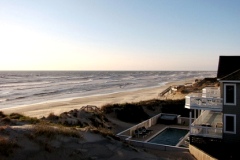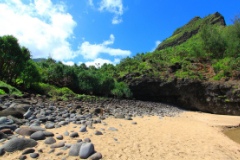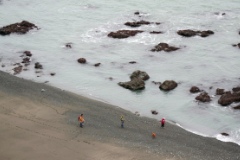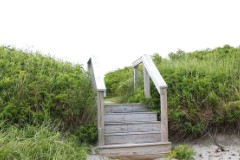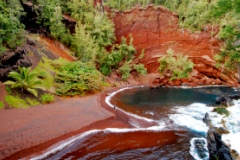
This time of year, it seems like everyone is heading to the beach. And it's always the same beach. We all feel our summer vacation routines growing old and tired; like we've been there and surfed that. Don't worry -- the good ol' USA has plenty of alternatives to your tired warm-weather repertoire. There are some less-visited but still spectacular beaches that await travelers willing to work up a little sweat (hiking, climbing, even chartering a boat) before hitting the shore. Here are some of the most secluded beaches in America that are worth the journey to get there.
Wildcat Beach, CA
The occasional visitors at Wildcat Beach at the southern end of the Point Reyes National Seashore aren't swimmers. Normally, they're travelers on a hiking or biking trip. In fact, you might even decide not to wear a swimsuit as you trek through the wilderness to reach this beach -- those in the know suggest you opt for clothes that cover your arms and legs since poison oak is one of the only permanent "residents" of the area. We suggest cargo pants -- so that you can tuck a camera away safely as you scramble along some of the less-graded trails. For your trouble, you'll find a peaceful stretch of beautiful cocoa sand, not to mention one of California's only tide falls (a waterfall that empties out onto a beach). Those who want to stay overnight usually set up tents in the Wildcat Campgrounds, located in a meadow overlooking the shore.
How to Find It: The best and shortest way to Wildcat is to hike five miles, starting at the Point Reyes' Palomarin trailhead, then on to the Coast Trail. From there you'll run onto the Wildcat shore. The Alamere tide fall is approximately one mile farther south of the trailhead. Visit the reserve's Web site for more hiking and campground details.
The Outer Banks town of Carova remains unpaved to prevent commercial development and tourist crowds.
jvader33 / Flickr
Carova Beach, NC
You'll need a four-wheel drive vehicle to reach the 11 miles of oyster-hued sands of Carova. This town in northern Outer Banks doesn't have any paved roads, and those who try to make the journey in less secure transport have gotten stuck in the sand. There are also no grocery stores, no hotels, no restaurants and no gas stations. According to this beach's official Web site, area residents want their roads to remain sandy in the hopes of warding off commercial development and tourist hordes. Certain travelers don't seem to mind the limited exposure and activities, especially since it has kept OBX beaches like Carova clean and safe. And there are ways to stay overnight, like at one of the luxury rental homes that dot the sand. Companies like HomeAway.com and Twiddy.com provide listings for Carova's seafront mansions, some of which can sleep up to 20 people comfortably.
How to Find It: To reach Carova, drive north on N.C. 12 going toward Corolla. Take a left at the ramp in the road and then continue on until you hit the shore.
Hanakapi'ai is one of the more beautiful beaches on Kauai -- and that's saying something. Those who visit the area must travel two miles on foot.
roy.luck / Flickr
Hanakapi'ai Beach, HI
You shouldn't try swimming in the tempestuous tides at Hanakapi'ai Beach, found along Kauai's elusive Na Pali Coast. But we do recommend packing a picnic to enjoy the spectacular scenery -- from the graham-cracker-colored sand, to the sparkling aquamarine water, to the emerald-colored grass and moss-covered cliffs. You'll probably need the refreshment by the time you finish making the two-mile, sometimes-hilly hike along the footpath that leads to the water. Fortunately, you'll find overnight camping options nearby once you arrive, so you can rest before trucking it back from no-man's land. Overnight camping is allowed in the area for $20 per person, per night; most people choose the valleys of Hanakapi'ai, Hanakoa or at Kalalau.
How to Find It: Hanakapi'ai and the surrounding Kalalau Trail are completely inaccessible by car. So wear some good shoes to start your hike at Kauai's Ha'ena State Park off of the Kuhio Highway, following the footpath to the clearing at Hanakapi'ai. Free hiking permits and camping permits are available at the state park's office or online.
Try to visit Enderts, located in the Redwood National and State Parks, in March, April, November or December. That's when migrating whales dot the shoreline.
Social Geek / Flickr
Enderts Beach, CA
Enderts is one of the easier-to-reach beaches on this list. You only need to walk about a half-mile away from the highway -- and civilization -- to make it down to the shoreline. So it's not the exertion in getting there that makes this beach so exclusive; but rather the fact that so few people actually know this beach exists in the first place. Enderts is just one of the beaches found along approximately 37 miles of coastline at the Redwood National and State Parks; most vacationers spend their trips to the area gazing up at the lofty trees rather than looking out on the rolling sea. Enderts isn't as photogenic as other shorelines either; it's most often ridden with driftwood and marshes. The best time to visit is either March, April, November or December, when migrating whales can be seen cresting the beach's Pacific waters.
How to Find It: Enderts is part of the Crescent City area of the Redwood parks. You can park in a lot on Enderts Beach Road (accessed off Highway 101). From there you'll make a mostly downhill trek along what's called the Coastal Trail, following the signs that will lead you to the sand. Visit the Redwood parks Web site for more details.
The beach at Maine's Roque Bluffs is very pebbly but well stocked with grills, picnic tables and playgrounds.
nightthree / Flickr
Roque Bluffs State Park, ME
Ironically, one of the most family-friendly beaches on our list -- found inside eastern Maine's Roque Bluffs State Park -- is too pebbly to be good for sunning or sandcastles. But the calm waters of the park's Englishman Bay and Simpson Pond are safe for young swimmers. And though Roque Bluffs beach is tucked behind fir trees and generally flies off the radar, it's also the beach on our list to offer the most facilities for visitors. People hunt down Roque because they like the convenience of nearby playgrounds, picnic tables, grills and peace and quiet.
How to Find It: The scenic drive to Roque Bluffs is part of what makes the beach so nice. Both park and beach is accessible through Route 1 in the town ofMachias. Take Route 1 to Roque Bluff Road and drive for about six miles, motoring past rose bushes, thick fir-tree cover and blueberry shrubs on the way to the park's entrance. Go to Roque Bluff's official Web site for more details.
The only way to reach the beaches of Cayo Costa -- off the Gulf Coast of Florida -- is by boat.
wildxplorer / Flickr
Cayo Costa, FL
Psst -- don't tell anyone, but one of the best times to visit Cayo Costa is winter. That's the season when this barrier island off Florida's southern Gulf Coast delivers some divine shells for collectors. At other times of year, you'll have to "make do" with the brilliant sunshine, crystalline water and soft buff sands that characterize approximately nine miles of coastline. Cayo Costa remains relatively untouched because of its remoteness -- your only access to its beaches is by boat -- but also because of its limited lodging. There are only about 12 cabins (which sleep up to six people each) and 30 tent sites. A concessionaire ferry makes several trips back and forth to the island selling food.
How to Find It: To visit Cayo Costa, you must take a charter boat or passenger ferry. Both options usually leave from the Jug Creek Marina in Bokeelia, FL, on Pine Island. It costs $2 to enter the park, and ferry fees range from $20 to $25 without tax (price dependent on age). Visit the park's official Web site for more information.
Maui's gorgeous Kaihalulu Beach is so far off the beaten path that many travelers choose to sunbathe nude once they arrive.
Courtesy of nash / Flickr
Kaihalulu Beach, HI
Secluded is an understatement when it comes to Maui's Kaihalulu Beach, located on the island's eastern coast. You'll have to scamper down a fairly steep, slippery incline for about 10 minutes until you reach a narrow path that leads to the clearing of this spectacular beach. There's a huge payoff for your trouble: Crimson-colored sand, courtesy of eroded volcanic cinders that surround the shore. Come in the early morning for the most peace and quiet -- Kaihalulu may be well hidden, but it's also well known. Those brave souls that have also made the effort to visit often like to capitalize on the remoteness by sunbathing nude. Just keep in mind that you can't go into the waves to protect your modesty, since Kaihalulu's waves are too intense for swimmers.
How to Find It: You can start your trek to Kaihalulu, also known as the Red Sand Beach, behind the community center located off Uakea Road in Hana. Follow the well-trodden, cliff-hugging trail that snakes behind the center, past a cemetery (no kidding) and down to the beach.
